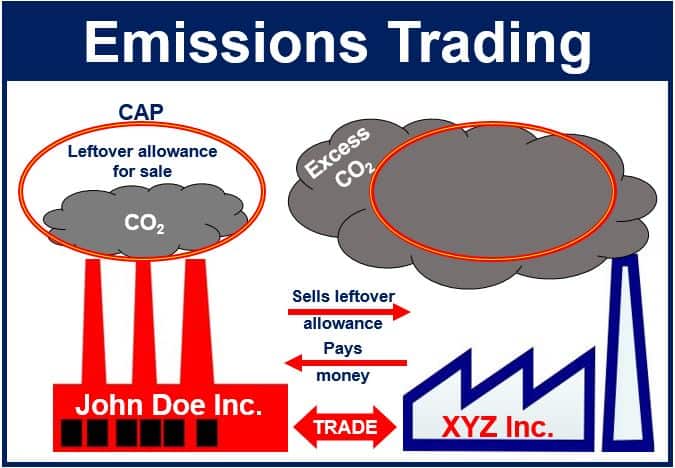The carbon market is a market in which we trade carbon emission allowances. Think of these allowances as permits to release a certain amount of carbon dioxide (CO2). The core idea is to encourage companies and countries to limit their CO2 emissions. By putting a financial value on these emissions, the market creates an incentive to reduce them.
Put simply, carbon emissions trading is an environmental policy device that places an economic cost on carbon emissions.
The terms carbon trading, emissions trading, and carbon emissions trading mean the same as ‘carbon market.’
How does it work?
A carbon market, in its most basic form, is based on the use of allowances or credits that give an entity the permission to emit a certain amount of greenhouse gases, with CO2 being the most typical.
Here’s a simple explanation:
- Setting a Cap: First, a regulatory body, such as a government, establishes a ceiling (or ‘cap’) on the total emission of greenhouse gases of a certain entity over a certain period.
- Issuing Allowances: These allowances are then provided to these entities either for free or through an auction. One allowance is the permission to emit one metric ton of CO2 (or other greenhouse gases).
- Trading: Companies that emit less than their allocated amount of greenhouse gases can sell their surplus allowances to those that exceed their limits. This creates a financial incentive for entities to reduce their emissions. Those that can reduce emissions cheaply will do so and sell their extra allowances for a profit, while those that find it more costly to reduce emissions can buy allowances, ideally incentivizing innovation in emission reduction technologies
- Monitoring and Compliance: Emissions are measured and controlled. It is a penalty to emit more than the allowances given.
This system is to help reach emission reduction in the most economical way, through market mechanisms.
As governments set a price for CO2 emissions, businesses subsequently have to pay for the amount of carbon they emit. This creates an economic incentive not to pollute.
In the European Union carbon market, for example, companies have to operate within a CO2 cap. Those emitting too much can buy allowances from low-emitting corporations. In other words, they can buy from companies that emitted below their limit.
An effective policy instrument
Countries often rely on carbon markets to finance parts of their Nationally Determined Contributions, or NDCs. NDCs are officially stated climate goals under the Paris Agreement. They rely on carbon markets to finance NDCs because these markets can attract significant private investment.
The UNDP highlights the growing importance of carbon markets in driving climate action. Many countries are increasingly looking to carbon markets as a key tool to finance the transformation needed to address the climate crisis. In fact, 83% of countries with climate pledges (NDCs) express an intention to use international market mechanisms to reduce greenhouse gas emissions.
For example, the EU Emissions Trading System (EU ETS) has proven to be effective. It helped drive down emissions from electricity and heat generation and industrial production by 47% since its launch in 2005. In 2023, emissions from these sectors saw the highest annual decrease to date, of 16.5% compared to 2022, driven largely by the increased use of renewable energy sources in the power sector.
And it’s not just the EU. China launched the world’s largest ETS in 2021, covering around one-seventh of global carbon emissions from fossil-fuel burning.
However, critics argue that carbon markets can allow heavy emitters to continue polluting if they can afford to buy credits. While others highlight concerns about the accuracy of carbon offset projects.
Carbon market – emissions
CO2 emissions occur when carbon dioxide is released into the atmosphere. Human activities or natural processes release the gas. For example, the burning of fossil fuels is a human activity. In fact, even food waste contributes to emissions, say German scientists.

The Earth has natural processes that remove carbon from the atmosphere. These processes keep the naturally-emitted CO2 levels stable. Animal and plant respiration are examples of natural carbon emissions.
The Earth cannot remove carbon emissions that human activities cause. Since the Industrial Revolution, CO2 concentrations in the atmosphere have increased considerably.
CO2 is a greenhouse gas. Greenhouse gases contribute to the greenhouse effect by absorbing infrared radiation. Carbon dioxide traps heat as it travels upwards away from Earth towards space.
If we fail to stop CO2 levels from rising, global warming will accelerate. In fact, scientists today warn that the consequences are potentially life-threatening.
Carbon market – offsetting
While cap-and-trade focuses on limiting and trading allowances within regulated sectors, carbon offsetting lets companies, organizations, or individuals compensate for their emissions by funding projects that reduce or capture greenhouse gases elsewhere.
Carbon offsetting is the process by which companies and households can compensate for the release of greenhouse gas (GHG) emissions.
Households and companies do this by funding certified GHG reduction projects. These projects either destroy the emissions or sequestrate CO2. They also fund projects that prevent emissions elsewhere.
A carbon credit is a financial unit of measurement. It represents the removal of one tCO2e from the atmosphere. tCO2e stands for tonne of carbon dioxide equivalent.
Carbon credits come from successful greenhouse-gas-emission reduction projects. In other words, projects that deliver reductions in emissions. They reduce emission by either replacing the use of fossil fuels with renewable energy or reducing fossil fuel usage through energy efficiency.
Carbon credits also come from capturing and storing released carbon in plants.
